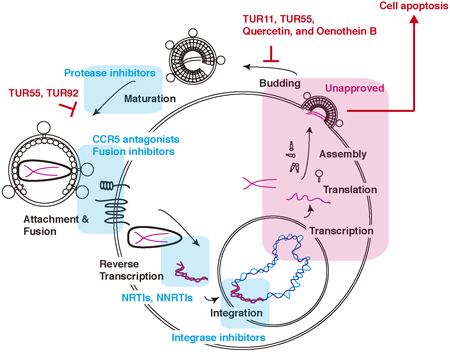- 著者
- Yurika Tahara Mikako Fujita Tianli Zhang Dongxing Wang Hiroshi Tateishi Akihiro Togami Perpetual Nyame Hiromi Terasawa Nami Monde Joyce Appiah-Kubi Wright Ofotsu Amesimeku Doaa Husham Majeed Alsaadi Mikiyo Wada Koji Sugimura Sevgi Gezici Halilibrahim Ciftci Faruk Karahan Nazim Sekeroglu Masami Otsuka Tomohiro Sawa Yosuke Maeda Takashi Watanabe Kazuaki Monde
- 出版者
- The Pharmaceutical Society of Japan
- 雑誌
- Biological and Pharmaceutical Bulletin (ISSN:09186158)
- 巻号頁・発行日
- vol.46, no.11, pp.1535-1547, 2023-11-01 (Released:2023-11-01)
- 参考文献数
- 67
The introduction of combined anti-retroviral therapy (cART) in 1996, along with a continual breakthrough in anti-human immunodeficiency virus-1 (HIV-1) drugs, has improved the life expectancies of HIV-1-infected individuals. However, the incidence of drug-resistant viruses between individuals undergoing cART and treatment-naïve individuals is a common challenge. Therefore, there is a requirement to explore potential drug targets by considering various stages of the viral life cycle. For instance, the late stage, or viral release stage, remains uninvestigated extensively in antiviral drug discovery. In this study, we prepared a natural plant library and selected candidate plant extracts that inhibited HIV-1 release based on our laboratory-established screening system. The plant extracts from Epilobium hirsutum L. and Chamerion angustifolium (L.) Holub, belonging to the family Onagraceae, decreased HIV-1 release and accelerated the apoptosis in HIV-1-infected T cells but not uninfected T cells. A flavonol glycoside quercetin with oenothein B in Onagraceae reduced HIV-1 release in HIV-1-infected T cells. Moreover, extracts from Chamerion angustifolium (L.) Holub and Senna alexandrina Mill. inhibited the infectivity of progeny viruses. Together, these results suggest that C. angustifolium (L.) Holub contains quercetin with oenothein B that synergistically blocks viral replication and kills infected cells via an apoptotic pathway. Consequently, the plant extracts from the plant library of Turkey might be suitable candidates for developing novel anti-retroviral drugs that target the late phase of the HIV-1 life cycle.
- 著者
- Tianli Zhang Hiroyasu Tsutsuki Katushiko Ono Takaaki Akaike Tomohiro Sawa
- 出版者
- SOCIETY FOR FREE RADICAL RESEARCH JAPAN
- 雑誌
- Journal of Clinical Biochemistry and Nutrition (ISSN:09120009)
- 巻号頁・発行日
- pp.20-13, (Released:2020-06-19)
- 参考文献数
- 46
- 被引用文献数
- 20
Cysteine persulfide (CysSSH) and polysulfides (CysS[S]nH, n>1) are cysteine derivatives having sulfane sulfur atoms bound to cysteine thiol. Recent advances in the development of analytical methods for detection and quantification of persulfides and polysulfides have revealed the biological presence, in both prokaryotes and eukaryotes, of persulfide/polysulfide in diverse forms such as CysSSH, glutathione persulfide and protein persulfides. Accumulating evidence has suggested that persulfide/polysulfide species may involve in a variety of biological events such as biosyntheses of sulfur-containing molecules, tRNA modification, regulation of redox-dependent signal transduction, mitochondrial energy metabolism via sulfur respiration, cytoprotection from oxidative stress via their antioxidant activities, and anti-inflammation against Toll-like receptor-mediated inflammatory responses. Development of chemical sulfur donors may facilitate further understanding of physiological and pathophysiological roles of persulfide/polysulfide species, including regulatory roles of these species in immune responses.
- 著者
- Ayaka Harada Hiroyasu Tsutsuki Tianli Zhang Ruda Lee Kinnosuke Yahiro Tomohiro Sawa Takuro Niidome
- 出版者
- The Pharmaceutical Society of Japan
- 雑誌
- Chemical and Pharmaceutical Bulletin (ISSN:00092363)
- 巻号頁・発行日
- vol.68, no.4, pp.363-368, 2020-04-01 (Released:2020-04-01)
- 参考文献数
- 39
- 被引用文献数
- 7
Poly(D,L-lactide-co-glycolic) acid (PLGA) is a synthetic copolymer that has been used to design micro/nanoparticles as a carrier for macromolecules, such as protein and nucleic acids, that can be internalized by the endocytosis pathway. However, it is difficult to control the intracellular delivery to target organelles. Here we report an intracellular delivery system of nanoparticles modified with bacterial cytotoxins to the endoplasmic reticulum (ER) and anti-inflammatory activity of the nanoparticles. Subtilase cytotoxin (SubAB) is a bacterial toxin in certain enterohemorrhagic Escherichia coli (EHEC) strains that cleaves the host ER chaperone BiP and suppresses nuclear factor-kappaB (NF-κB) activation and nitric oxide (NO) generation in macrophages at sub-lethal concentration. PLGA-nanoparticles were modified with oligo histidine-tagged (6 × His-tagged) recombinant SubAB (SubAB-PLGA) through a pH-sensitive linkage, and their translocation to the ER in macrophage cell line J774.1 cells, effects on inducible NO synthase (iNOS), and levels of tumor necrosis factor (TNF)-α cytokine induced by lipopolysaccharide (LPS) were examined. Compared with free SubAB, SubAB-PLGA was significantly effective in BiP cleavage and the induction of the ER stress marker C/EBP homologous protein (CHOP) in J774.1 cells. Furthermore, SubAB-PLGA attenuated LPS-stimulated induction of iNOS and TNF-α. Our findings provide useful information for protein delivery to macrophages and may encourage therapeutic applications of nanoparticles to the treatment of inflammatory diseases.

